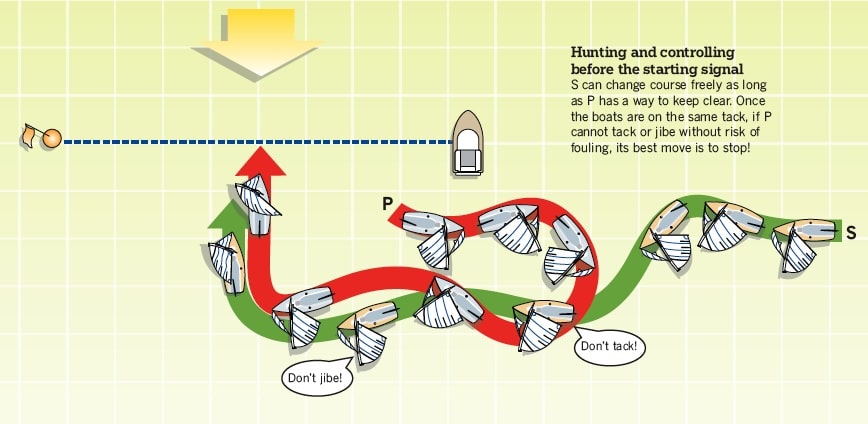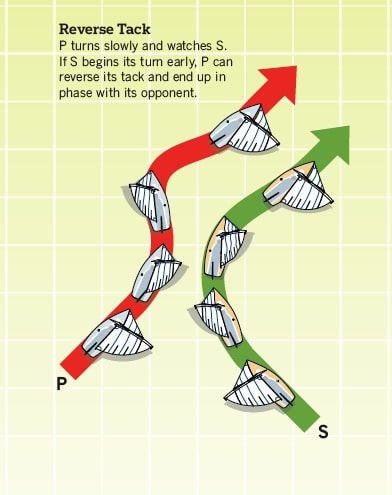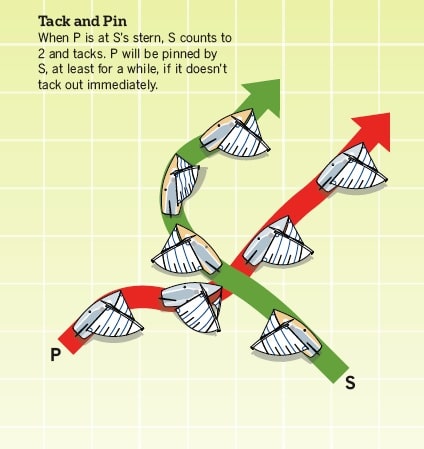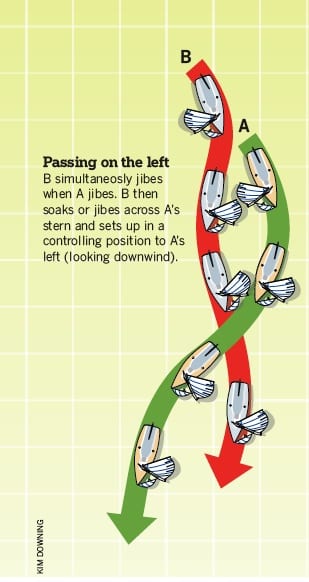As much as everyone likes to pass boats in bunches, sometimes the road to a better finish involves stepping over one boat at a time. Maybe the battle is for position during the start sequence or when nearing a mark, or maybe the goal is to force another boat to have a bad race near the end of a series. Regardless of the situation, when two boats become locked in battle, the sailor or team with match racing experience usually dominates. With that in mind, here are some match-racing moves you can use in fleet racing to ensure you have the upper hand, or at least a clue on how to defend if you find yourself under attack.
Protect the Starboard Card
When two boats engage, the boat on starboard—the one with the Starboard Card—has tremendous power over the boat on port. Whenever possible, be on starboard tack when you converge with an opponent. In general, this means you want to stay to the right of your targeted opponent on the upwind legs, and to the left (looking downwind) on the downwind legs.
If you are on port tack approaching a starboard-tack opponent, it’s usually stronger to cross behind and then tack or jibe to its right (when sailing upwind) or left (downwind). I often say that when a port-tack boat passes just astern of a starboard-tack boat, it is ahead in the race. This is true upwind and downwind.
On the other hand, if you are on starboard, use the Starboard Card. If you allow your opponent to pass astern, you give up the Card without a fight. If the next crossing is close, your opponent is likely to have the advantage. Upwind, if you want to defend the right, and you are unable to force your opponent to tack back to starboard, a leebow tack is the best option. This is more difficult to do when you are on starboard tack, as the port-tack boat will be bearing away to duck. You’ll need to start your turn
a little sooner than you would when executing a leebow tack from port to starboard. Downwind, if you can’t force your opponent to jibe, you must jibe before he or she gets near you so you can save your Starboard Card for later use.

Hunting and controlling during the pre-start
During the time between the preparatory signal and the starting signal, a boat on starboard tack can change course freely near a port-tack boat as long as the port-tack boat always has a seamanlike way of reacting to the course change and keeping clear (Rule 16.1). This makes the pre-start an excellent opportunity to go on the offensive. You’ll need to be to your opponent’s right—looking upwind—to have the greatest control. The Starboard Card is particularly powerful if you are to the left of the right-hand (committee boat) end of the line. Make note that after the starting signal, Rule 16.2 prohibits a starboard-tack boat from changing course near a port-tack boat when it is trying to pass astern.
**The Move **
In a port-starboard confrontation before the start, you (S) can make P jibe to keep clear, and then force P farther down the line than it might like to go. Once you are astern of P, especially with both boats on starboard tack, it’s easy to prevent P from tacking or jibing by cutting off the escape route each time P turns up or down.
**The Counter **
For P, who finds it’s impossible to tack or jibe without the risk of fouling S, the safest move is to stop, using a sharp turn up to head to wind, followed by pushing the main out hard for a few seconds to kill speed. The safest location to perform such a stop is two lengths to the right of the right-hand end of the starting line.

Upwind: the reverse tack
**The Move **
You (P) are slightly ahead of your opponent (S)—on the opposite tack—and want to tack onto his air and get in phase with him. You know, however, that S will likely tack away when you do so. Turn a little more slowly as you start your tack and keep a close eye on S. If S begins his turn before you are well past head to wind, smoothly reverse your turn (be sure to warn your crew you may do this). S will either complete its tack, in which case you will be in phase with S and in a controlling position, or S will freeze head to wind, in which case you remain head to wind directly upwind of S, waiting to match its next move. This works best in medium to heavy wind and relatively flat water.
**The Counter **
S should wait for P to get all the way to close-hauled on the new tack before beginning its tack. And, if P decides to reverse its turn, then S should complete the initial tack—never stopping head to wind—and then immediately tack back to get out of phase.

Tack and Pin (aka “The Soft Slam Dunk”)
The Move You (S) are in front of your opponent (P) and you want to protect the right for a short period of time. In this example, you’re on starboard tack and a few boatlengths off the starboard layline as you cross ahead of P, on port tack. Count to two afer P’s bow passes your stern, then tack. Your goal is to be far enough to windward of P that if P luffs head to wind, she cannot touch your boat. Tacking sooner is called a Slam Dunk, and is very risky for the tacking boat. The Tack and Pin is a less risky option.
**The Counter **
When P sees S tack, its goal should be to tack before its bow becomes locked to leeward of S. By waiting until S is close-hauled on port before tacking, P is rewarded with clear air on starboard tack. S, on the other hand, will need to quickly build speed and tack back to avoid overstanding the mark, and retains the Starboard Card for the next crossing situation. Note, if P begins its turn before S is past head to wind, S can pull a Reverse Tack (see above) to stay in phase. If P remains on port tack, its faster speed—S will be slower coming out of the tack—will quickly put P into a position where it cannot tack, and S should be able to hold P on port for as long as needed.
Covering your opponent downwind
On downwind legs, the trailing boat has the advantage. A trailing boat that is within two lengths of an opponent should be able to make the pass. The key is to establish a position that blocks the lead boat’s wind. To determine if you’re on your opponent’s wind, look at its wind indicators (masthead wind indicator, shroud telltales, etc.). Typically, you can only blanket the other boat on one tack. If your opponent’s wind is more than a length ahead of you, don’t chase it. Instead, set up to blanket its wind after the jibe. The best position for this maneuver is a half to a full boatlength to leeward of your opponent’s centerline.

Pass on the left
When you blanket your opponent, you will close the distance, and as you do so, you will need to make a big decision: do you try to pass to its right or to its left (looking downwind)? Passing to its left will give you the Starboard Card. In addition, if the mark to which you are racing is to be left to port, you will gain the powerful inside position.
**The Move **
You are trailing your opponent on a run. You’re both on port tack and you know that at some point the boat ahead will jibe. You must continually assess whether you are in a good position to blanket it, if you jibe simultaneously (called a “Simo Jibe”). If you are on, or to windward of, your opponent’s centerline, you probably won’t be in a position to take its wind afer a Simo Jibe. In that case, when your opponent jibes, cross over and jibe to its left. If you are two to three lengths behind, and to leeward of your opponent’s centerline, you should be able to Simo Jibe and hit its wind, or be close enough to its wind that it will head up in an effort to keep its wind clear; either way you will gain.
Let’s assume you Simo Jibe onto starboard, hit your opponent’s wind, and reduce its lead. Just before you get locked to windward, you need to make your move to get to the left. You have two options, and which one you choose will depend on the wind speed and your distance to windward. You can sail deep (“soak”) and end up to leeward of your opponent, or jibe, sail across its stern for one to two lengths, and then jibe back to its left. Once you are to the left of him or her, with both of you on starboard tack, you’re in control.
**The Counter **
The boat ahead must do what it can to ensure that the trailing boat, if it makes a pass, does so to its right. The exception is in a situation where the trailing boat could then sail over the leading boat and make it to the zone of a left-hand leeward mark (port rounding) clear ahead or to the zone of a right-hand leeward mark (starboard rounding) overlapped on the inside. A leading boat on starboard tack must defend its left side. Therefore, whether the trailing boat soaks or jibes, the leading boat needs to match the move instantly to preserve its left-hand position.
You now know enough to be dangerous. If you want to become more proficient in these moves, and learn plenty more, give match racing a try. Most sailors who have tried match racing say it instantly made them more successful fleet racers by sharpening their awareness of boat-on-boat tactics and the rules, their boat handling under pressure, and their critical time and distance calculations in the pre-start and around the course. Plus it’s a lot of fun for the entire crew.









